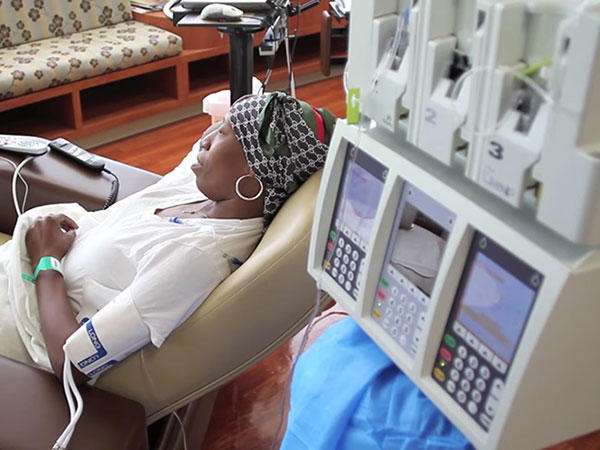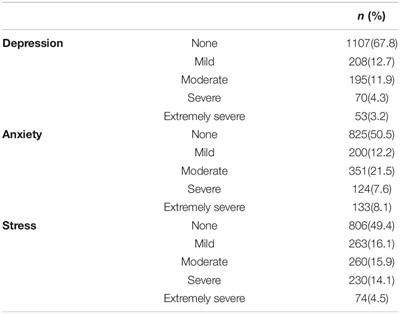Types of Cancer Treatment 
Credit: National Cancer Institute
There are many types of cancer treatment. The types of treatment that you receive will depend on the type of cancer you have and how advanced it is.
Some people with cancer will have only one treatment. But most people have a combination of treatments, such as surgery with chemotherapy and radiation therapy. When you need treatment for cancer, you have a lot to learn and think about. It is normal to feel overwhelmed and confused. But, talking with your doctor and learning about the types of treatment you may have can help you feel more in control. Our list of Questions to Ask Your Doctor About Treatment may help.
-

Biomarker Testing for Cancer Treatment
Biomarker testing is a way to look for genes, proteins, and other substances (called biomarkers or tumor markers) that can provide information about cancer. Biomarker testing can help you and your doctor choose a cancer treatment.
-

Chemotherapy
Chemotherapy is a type of cancer treatment that uses drugs to kill cancer cells. Learn how chemotherapy works against cancer, why it causes side effects, and how it is used with other cancer treatments.
-

Hormone Therapy
Hormone therapy is a treatment that slows or stops the growth of breast and prostate cancers that use hormones to grow. Learn about the types of hormone therapy and side effects that may happen.
-

Hyperthermia
Hyperthermia is a type of treatment in which body tissue is heated to as high as 113 °F to help damage and kill cancer cells with little or no harm to normal tissue. Learn about the types of cancer and precancers that hyperthermia is used to treat, how it is given, and the benefits and drawbacks of using hyperthermia.
-

Immunotherapy
Immunotherapy is a type of cancer treatment that helps your immune system fight cancer. This page covers the types of immunotherapy, how it is used against cancer, and what you can expect during treatment.
-

Photodynamic Therapy
Photodynamic therapy uses a drug activated by light to kill cancer and other abnormal cells. Learn how photodynamic therapy works, about the types of cancer and precancers it is used to treat, and the benefits and drawbacks of this treatment.
-

Radiation Therapy
Radiation therapy is a type of cancer treatment that uses high doses of radiation to kill cancer cells and shrink tumors. Learn about the types of radiation, why side effects happen, which side effects you might have, and more.
-

Stem Cell Transplant
Stem cell transplants are procedures that restore stem cells that grow into blood cells in people who have had theirs destroyed by high doses of chemotherapy or radiation therapy. Learn about the types of transplants, side effects that may occur, and how stem cell transplants are used in cancer treatment.
-

Surgery
When used to treat cancer, surgery is a procedure in which a surgeon removes cancer from your body. Learn the different ways that surgery is used against cancer and what you can expect before, during, and after surgery.
-

Targeted Therapy
Targeted therapy is a type of cancer treatment that targets the changes in cancer cells that help them grow, divide, and spread. Learn how targeted therapy works against cancer and about common side effects that may occur.
Overview
Cancer treatment is the use of surgery, radiation, medications and other therapies to cure a cancer, shrink a cancer or stop the progression of a cancer.
Many cancer treatments exist. Depending on your particular situation, you may receive one treatment or you may receive a combination of treatments.
Why it’s done
The goal of cancer treatment is to achieve a cure for your cancer, allowing you to live a normal life span. This may or may not be possible, depending on your specific situation. If a cure isn’t possible, your treatments may be used to shrink your cancer or slow the growth of your cancer to allow you to live symptom free for as long as possible.
Cancer treatments may be used as:
-
Primary treatment. The goal of a primary treatment is to completely remove the cancer from your body or kill all the cancer cells.
Any cancer treatment can be used as a primary treatment, but the most common primary cancer treatment for the most common types of cancer is surgery. If your cancer is particularly sensitive to radiation therapy or chemotherapy, you may receive one of those therapies as your primary treatment.
-
Adjuvant treatment. The goal of adjuvant therapy is to kill any cancer cells that may remain after primary treatment in order to reduce the chance that the cancer will recur.
Any cancer treatment can be used as an adjuvant therapy. Common adjuvant therapies include chemotherapy, radiation therapy and hormone therapy.
Neoadjuvant therapy is similar, but treatments are used before the primary treatment in order to make the primary treatment easier or more effective.
-
Palliative treatment. Palliative treatments may help relieve side effects of treatment or signs and symptoms caused by cancer itself. Surgery, radiation, chemotherapy and hormone therapy can all be used to relieve symptoms. Other medications may relieve symptoms such as pain and shortness of breath.
Palliative treatment can be used at the same time as other treatments intended to cure your cancer.
What you can expect
Many cancer treatments are available. Your treatment options will depend on several factors, such as the type and stage of your cancer, your general health, and your preferences. Together you and your doctor can weigh the benefits and risks of each cancer treatment to determine which is best for you.
Cancer treatment options include:
- Surgery. The goal of surgery is to remove the cancer or as much of the cancer as possible.
- Chemotherapy. Chemotherapy uses drugs to kill cancer cells.
- Radiation therapy. Radiation therapy uses high-powered energy beams, such as X-rays or protons, to kill cancer cells. Radiation treatment can come from a machine outside your body (external beam radiation), or it can be placed inside your body (brachytherapy).
-
Bone marrow transplant. Your bone marrow is the material inside your bones that makes blood cells from blood stem cells. A bone marrow transplant, also knowns as a stem cell transplant, can use your own bone marrow stem cells or those from a donor.
A bone marrow transplant allows your doctor to use higher doses of chemotherapy to treat your cancer. It may also be used to replace diseased bone marrow.
- Immunotherapy. Immunotherapy, also known as biological therapy, uses your body’s immune system to fight cancer. Cancer can survive unchecked in your body because your immune system doesn’t recognize it as an intruder. Immunotherapy can help your immune system “see” the cancer and attack it.
- Hormone therapy. Some types of cancer are fueled by your body’s hormones. Examples include breast cancer and prostate cancer. Removing those hormones from the body or blocking their effects may cause the cancer cells to stop growing.
- Targeted drug therapy. Targeted drug treatment focuses on specific abnormalities within cancer cells that allow them to survive.
- Cryoablation. This treatment kills cancer cells with cold. During cryoablation, a thin, wandlike needle (cryoprobe) is inserted through your skin and directly into the cancerous tumor. A gas is pumped into the cryoprobe in order to freeze the tissue. Then the tissue is allowed to thaw. The freezing and thawing process is repeated several times during the same treatment session in order to kill the cancer cells.
- Radiofrequency ablation. This treatment uses electrical energy to heat cancer cells, causing them to die. During radiofrequency ablation, a doctor guides a thin needle through the skin or through an incision and into the cancer tissue. High-frequency energy passes through the needle and causes the surrounding tissue to heat up, killing the nearby cells.
- Clinical trials. Clinical trials are studies to investigate new ways of treating cancer. Thousands of cancer clinical trials are underway.
Other treatments may be available to you, depending on your type of cancer.
Clinical trials
Explore Mayo Clinic studies of tests and procedures to help prevent, detect, treat or manage conditions.
What are some words you associate with cancer? Chances are “chemotherapy” is one of the first that comes to mind. But chemo is not always the first course of treatment.
“These days, a cancer diagnosis doesn’t have to mean chemo — and the nausea, vomiting and hair loss most people think of,” says Susan Budds, NP, a nurse practitioner who specializes in cancer at RUSH.
In fact, sometimes chemo takes a back seat to other treatments that may have milder side effects. Thanks to new treatments and advances in personalized care, oncologists are now better able to tailor cancer treatment to each individual patient and the type of cancer they have.
Treatment 1: Surgery
Surgery is an option for most cancers other than blood cancers, with specialized cancer surgeons attempting to remove all or most of a solid tumor. It is an especially effective treatment for early stage cancers that haven’t spread to other parts of the body.
“While it depends on the size of the tumor and other factors, many patients with stage 1 cancers don’t need any other treatment except for surgery,” says Marta Batus, MD, a medical oncologist at RUSH.
And surgery can play a role in cancer treatment even when a tumor has spread beyond its original site.
“Our options for treating cancer — even at later stages — have grown, and surgery is a big part of that,” Budds says. “The role of surgery has expanded, and it’s very encouraging.”
Depending on the cancer and the stage, minimally invasive surgery may be an option. For example, thoracic surgeons at RUSH often use video-assisted thoracoscopic surgery (VATS), a minimally invasive procedure, to remove early stage lung cancer tumors. VATS uses smaller incisions than open surgery and typically offers patients less pain, shorter hospital stays after surgery and fewer complications.
Treatment 2: Immunotherapy
Immunotherapy, a relatively newer type of cancer treatment, uses medications to rev up the patient’s own immune system to fight cancer. Immunotherapy treatments can work across different cancer types and may be effective in treating even the most advanced and hard-to-treat cancers.
Researchers continue to look into the potential of immunotherapy, but several effective, FDA-approved drugs are now commonly used to treat certain cancers.
“Immunotherapy has definitely opened up more options for a lot of patients, and it is now the frontline treatment for certain patients,” Batus says. “Patients don’t lose their hair. They don’t have nausea or vomiting. Most of the time, they experience minimal side effects, if any.”
Some patients, though, may experience side effects, depending on the drug administered and the type of cancer being treated.
Immunotherapies are administered through an IV infusion.
And immunotherapy gives some patients with late-stage cancers a treatment option they previously didn’t have, sometimes allowing them to live longer than they would have been expected to live otherwise. For example, immunotherapy has redefined how doctors are treating melanoma, the most dangerous and deadly form of skin cancer. Five years ago, overall survival for a person diagnosed with metastatic melanoma (cancer that has spread to other parts of the body) was about nine months. Today, thanks to combination immunotherapies, the majority of patients with metastatic melanoma are alive and doing well at least one year later — and many are living many years beyond that.
Treatment 3: Targeted therapies
Oncologists use targeted therapies, also known as precision medicine, to tailor medications for each individual patient and cancer. A tumor or blood sample is tested to identify a genetic profile. That allows clinicians to administer medication that targets the genes that are causing the cancer.
“There could be five or six gene processes that turn a cancer on or off,” Budds says. “With genetic testing, we can find out which medicines to use and which ones not to use.”
Medications, delivered in pill or IV form, either destroy cancer cells or stop the cancer from continuing to grow. Like immunotherapy, targeted therapies can be used at any stage: as a first treatment, to keep the cancer from coming back or if a cancer returns.
For instance, patients with breast cancer are typically tested to see if they carry the HER2 gene, which can play a role in causing breast cancer cells to grow. If a patient tests positive for HER2, oncologists at RUSH use a medication or a combination of medications developed to target the gene, such as trastuzumab or pertuzumab. These medications help stop the growth of the cancer cells, often without harming healthy cells.
These days, a cancer diagnosis doesn’t have to mean chemo — and the nausea, vomiting and hair loss most people think of.
Treatment 4: Active surveillance
Active surveillance (also called watchful waiting) may be all that’s needed for certain types of cancers. Your doctor may recommend this approach if the cancer is at an early stage and is growing slowly or not at all.
For example, doctors often recommend active surveillance for prostate cancer, which tends to grow very slowly. Doctors monitor patients’ prostate-specific antigen (PSA) with blood tests and monitor symptoms. If or when symptoms worsen or tests show that the cancer is growing more rapidly, they then begin discussing additional treatments.
“Often, patients who are receiving active surveillance have no symptoms and go on living their lives as usual,” Batus says.
Surveillance may also be an option for patients who want a break from treatment side effects or for those who have exhausted all other treatment options.
Treatment 5: Supportive care
Supportive cancer care can be an effective complement to standard treatment, helping to minimize the physical and emotional stress of cancer treatment.
For example, psychotherapy and massage therapy can help ease patients’ anxiety as they cope with a diagnosis; acupuncture can be beneficial for pain relief; and nutrition counseling can keep a patient from losing too much weight during treatment and keeping their body as healthy as possible.
Other types of integrative medicine include the following:
• Aromatherapy
• Fitness classes
• Hypnosis
• Mindfulness meditation
“Anything you can do to keep a patient mentally and physically well while they handle the stress of having cancer is beneficial,” Budds says. “It’s just one of the growing set of tools we have to help our patients deal with cancer. We’ve come a long way in recent years.”




